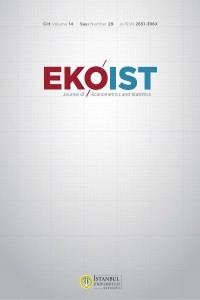TÜRKİYE CUMHURİYET MERKEZ BANKASI BAĞIMSIZLIĞI DEZENFLASYONİST ETKİ YARATIR MI?
Bu çalışmada, Türkiye'deki yurtiçi toplam kredi hacmi ile cari işlemler açığı arasındaki ilişki, 1992Q1-2012Q3 dönemi verileri kullanılarak, Carrion-i-Silvestre (2009) çoklu yapısal kırılmalı birim kök testi ve Maki (2012) çoklu yapısal kırılmalı eşbütünleşme yöntemiyle araştırılmıştır. Elde edilen bulgulara göre; yurtiçi toplam kredi hacmi artışıyla cari işlemler açığı arasında, eşbütünleşmenin varlığı tespit edilmiş ve yurtiçi kredi hacmindeki artışın, cari işlemler açığını arttırıcı bir faktör olduğu görülmüştür. Hata düzeltme modelinde ise, uzun dönemde birlikte hareket eden seriler arasında kısa dönem sapmalarının ortadan kalktığı gözlenmiştir.
Anahtar Kelimeler:
Merkez Bankası Bağımsızlığı, Enflasyon, VECM, Eş Bütünleşme
-
-
Keywords:
Central Bank Independence, Inflation, VECM, Co-integration.,
___
- Alesina, A. and Summers, L.H. 1993. Central Bank Independence And Macroeconomic Performance: Some Comparative Evidence. Journal of Money Credit And Banking, 25(2).
- Barışık, S. 2004. Merkez Bankası Bağımsızlığı, Makroekonomik Etkileri ve 2001 Tarihli TCMB Kanununun Yansımaları. Ankara Üniversitesi SBF Dergisi,59(3).
- Campillo, M., and Miron, J. A. (1997). Why does inflation differ across countries?. In Reducing inflation: Motivation and strategy (pp. 335-362). University of Chicago Press.
- Cukierman, A., Web, S. B., and Neyapti, B. 1992. Measuring the independence of central banks and its effect on policy outcomes. The World Bank Economic Review, 6(3), 353-398.
- Cukierman, A. 1994. Central Bank Strategy, Credibility, and Independence: Theory And Evidence, The MIT Press.
- Cukierman, A. 1998. The Economics Of Central Banking. In:Wolf, H. (Ed.), Iea, Contemporary Economic Issues—Macroeconomics And Finance. The Macmillan Press, London, p. 37–82.
- Daunfelt, S.O and De Luna, X. 2008. Central Bank İndependence and Price Stability: Evidence From OECD Countries, Oxford Economis Papers, 60 (3): 410-422.
- De Haan, J.and Kooi, J. W. 2000. Does Central Bank Independence Really Matter? New Evidence For Developing Countries Using A New Indicator. Journal Of Banking And Finance, 24(4), p.643-664.
- Doğru, B. 2012. Merkez Bankası Bağımsızlığının Çıktı Açığına Etkisi: Türkiye Örneği. Dumlupınar Universıty Journal of Socıal Scıences, Sayı: 35: 25-40.
- Dufour, M. ve Orhangazi, Ö. 2009. The 2000-2001 Financial Crisis in Turkey: A Crisis for Whom?”, Review of Political Economy, 21(1): 101-122.
- Eijffinger, S. C.W. and Schaling, E. 1992. Central Bank Independence: Criteria and Indices. Reserarch Memorandum, No 548.
- Eijffinger, S., Schaling, E., and Hoeberichts, M. 1998. Central bank independence: A sensitivity analysis. European Journal of Political Economy, 14(1), 73-88.
- Eroğlu, Ö. ve Altıntaş, H. 1997. Merkez Bankasının Bağımsızlığı Sorunu: Enflasyon ve Ekonomik Performans Üzerine Bir Değerlendirme. İktisat İşletme ve Finans Dergisi, 12(135).
- Griffiths, W., vd. 2010. Using Eviews for Principle of Econometrics, 3rd Ed., Jonh Willey.
- Grilli, M., Tabellini, D., Malinvaud,G., E. and Pagano, M. (1991). Political and monetary institutions and public financial policies in the industrial countries. Economic policy, 342-392.
- Gutierrez, E. 2003. Inflation performance and constitutional central bank independence: evidence from Latin America and the Caribbean.
- Günsoy, B. 2000. Hukuksal Yapı ve İktisadi Başarı :TCMB Örneği. İ.Ü.Siyasal Bilgiler Fakültesi Dergisi, No: 23-24.
- Hall, P. A. and R. J. Jr. Franzese. 1998. Mixed Signals: Central Bank Independence, Coordinated Wage-Bargaining, and European Monetary Union, International Organization, 52(3), 505-536.
- Hayo, B. 1998. Inflation Culture, Central Bank Independence and Price Stability, European Journal of Political Economy, 14, 241-263.
- Huang, T. 2011. Effects of Central Bank Independence Reforms on Inflation in Different Parts of the World (Doctoral dissertation, Dalarna University).
- Jacome, L. I., and Vazquez, F. 2008. Is There any Link Between Legal Central Bank İndependence and İnflation? Evidence from Latin America and The Caribbean. European Journal of Political Economy, 24(4), 788-801.
- Johansen, S., and Juselius, K. 1990. Maximum likelihood estimation and inference on cointegration—with applications to the demand for money. Oxford Bulletin of Economics and statistics, 52(2), 169-210.
- Kazgan, G. 2009. Tanzimat’tan 21.Yüzyıla Türkiye Ekonomisi, Bilgi Üniversitesi Yayınları, 4. Baskı, İstanbul.
- Klomp, J., and De Haan, J. (2010). Inflation and Central Bank Independence: A Meta‐Regression Analysis. Journal of Economic Surveys, 24(4), 593-621.
- Loungani, P. And Sheets, N. 1997. Central Bank Independence, Inflation, And Growth İn Transition Economies. Journal Of Money, Credit And Banking, Vol. 29, No. 3, p: 381-399
- Lucotte, Y. 2009. The Influence of Central Bank Independence on Budget Deficits in Developing Countries: New Evidence from Panel Data Analysis. Université d’Orléans, UMR CNRS, 6221
- Moser, P. 1999. Checks and balances, and the supply of central bank independence, European Economic Review, 43, 1569-1593.
- Oktar, S.1996. Merkez Bankasının Bağımsızlığı, Birinci Baskı, İstanbul: Bilim Teknik Yayınları.
- Posen, A S. 1995. Declarations Are Not Enough: Financial Sector Sources of Central Bank Independence. NBER Macroeconomics Annual, 10(25): 1-74.
- Posen, A.S. 1998. Central Bank Independence and Disinflationary Credibility: A Missing Link?,Oxford Economic Papers, 50, 335-359.
- Romer, C. ve Romer, D. 1997. Reducing Inflation: Motivation And Strategy. University of Chicago Press.
- Serdengeçti, S. 2003.Merkez Bankası Bağımsızlığı. Finansal Politik Ekonomik Yorumlar Dergisi 40 (477): 41-51.
- Sturm, J.E. and De Haan, J.2001. Inflation İn Developing Countries: Does Central Bank Independence Matter? New Evidence Based On A New Data Set. Ifo Studien, 47(4), p. 389-403.
- Walsh, C. 2005. Central Bank Independence. Prepared For The New Palgrave Dictionary. http://econ.ucse.edu
- Yayın Aralığı: Yılda 2 Sayı
- Yayıncı: İstanbul Üniversitesi
Sayıdaki Diğer Makaleler
TÜRKİYE CUMHURİYET MERKEZ BANKASI BAĞIMSIZLIĞI DEZENFLASYONİST ETKİ YARATIR MI?
İsmail KÜÇÜKAKSOY, Selcan ÖNAL
YÜKSEKÖĞRETİMDE HİZMET KALİTESİ ÖLÇEĞİ: GÜVENİLİRLİK VE GEÇERLİLİK ANALİZİ
Hakan BEKTAŞ, Sema ULUTÜRK AKMAN
TÜRKİYE’DE KADINLARIN İŞGÜCÜNE KATILIMILARININ KOHORT ANALİZİ
Fatma ZEREN, Burcu KILINÇ SAVRUL
KREDİ HACMİ ARTIŞININ CARİ AÇIĞA ETKİSİ: ÇOKLU YAPISAL KIRILMALI EŞBÜTÜNLEŞME ANALİZİ
